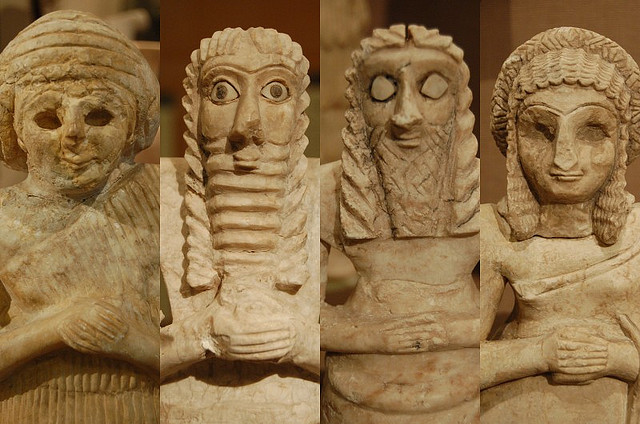The sculptures obtained from different civilisations give us insights into their ways of life. Mesopotamia, the greatest of the ancient civilisations also have sculptures to offer. Many of the sculptures are of gods and goddesses, some of kings and scribes and others miscellaneous.
Hundreds of statues and fragments are discovered from the area. A large number of statues were discovered in temples at the sites of Tell Asmar, Khafaje, and Tell Agrab close to the Diyala River, a major tributary of the Tigris in eastern Mesopotamia.

The statues of various sizes are covered in gypsum or limestone. In general, men wear fringed or tufted fleece skirts and women, fringed or tufted dresses draped over one shoulder.
The statues are usually carved with the hands clasped, right over left, at the chest or waist in a gesture of attentiveness. Some figures hold cups or branches of vegetation. Male statues were taller whereas female statues were smaller in size.
One of the famous statues from early dynasty is of a female standing with clasped hands. The period estimated is from 2600 to 2500 BC. It was a combination of limestone, shell and lapis lazuli.
The Tell Asmar statues are stylized with large eyes and are in a pose of supplication. These figures have lots of energy in their bright eyes, face and curling horns.
The statue of the He-goat in flowering tree was made in 2800 BC. It was 18 inches long. Portraying a golden goat, this was found in the Sumerian grave at Ur. The head and legs of the goat were made of wood overlaid with gold. Its coat is of shell, his horns and eyes are of lapis lazuli.
The head from Nineveh is another wonderful sculpture. It represents Naram-Sin. A bronze statue of a king, wearing a wig-helmet of the old Sumerian rulers is believed to be Sargon.
Scribes were those few persons in Mesopotamia who knew to write and read. When cuneiform script came to be largely used, scribes were in demand. As they were very important, sculptures were made as a tribute to them.
A stone sculpture of Ebi-H II, found at a temple of Ishtar is believed to be a minister of finance. The statute with clasped hands and wide eyes is made of a stone called alabaster.
The ziggurats were large temple towers of Mesopotamia. It was a huge structure built in the centre of the town. It was a terraced step pyramid with a flat top. Ziggurats were mostly built of sun-baked bricks. The facings of the ziggurats glazed in different colours. They were built in receding tiers upon square, rectangular or oval platform.
